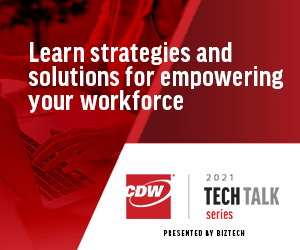Workplace Returns: A Technology-Driven Balancing Act
Stephen Miller, a technologist and brand ambassador for Lenovo, explained during the session that while employers may have used this time to improve their workplaces in anticipation for an office comeback, employees have been investing in their own home offices.
“If you want me to come to work three days a week, and I don’t want to, well, I might work somewhere else,” he said. “I expect to have that freedom, because I’ve spent money I’ve invested in my home to be more productive, and I’ve proved that I’ve become more productive.”
Miller suggested that a mix of factors would be required to make the workplace desirable enough for workers to return, including additional investment in technology and high cleanliness standards.
“I don’t work in a hospital, but I want to know that it’s clean,” he said.
These factors, Miller said, could lead to new workplace use cases, perhaps with employees visiting the office for short periods to collaborate.
“We need a space where nine of us can huddle together, knock this out in person, and then commute at 1 p.m., not at 4 p.m. in rush hour,” he said. “So, headquarters needs to evolve into a collaboration center.”
But at the center of all of this is increasing investment in technology, both in the workspace (for example, with conference rooms designed for multiple onsite users and remote employees alike) and for individual workers.
Miller spoke of the importance of offering USB-C docks in lieu of forcing employees to share keyboards and other input devices, as well as giving employees high-end technology to get their jobs done.
WATCH: How next-gen networking can power your business objectives.
With the expectation that employees might be working offsite more and, onsite, may be working without a permanent desk as workplaces shrink, Miller said, it’s going to be increasingly important for workers that they have access to the best technology available, given that, in the grand scheme, it’s not that expensive — and poor technology could discourage workers from sticking around.
Miller underlined this point using the example of a computer memory upgrade. “If, let’s just say, an employee makes $100,000 a year, over three years that’s $300,000, and you’re going to quibble over $100 difference in a piece of hardware? That’s $33 a year versus $100,000 a year,” he said. “Spend the money. Get the 32-gig machine.”
That said, some things will never change. Miller said, for example, that it’s unlikely laptops will be going away any time soon.
An Office Built for Collaboration
At 250,000 square feet, CDW’s new office at 625 West Adams Street in downtown Chicago is actually a bit smaller than the office it’s replacing.
But the downsizing is a good fit for the company’s functional needs, says Mike Wavrek, the director of real estate transaction management for CDW.
“The thought there was, ‘Hey, look, we can save a little bit on real estate costs if we start contemplating a more agile arrangement with respect to our seating arrangements and all the rest of it,’” he said.













